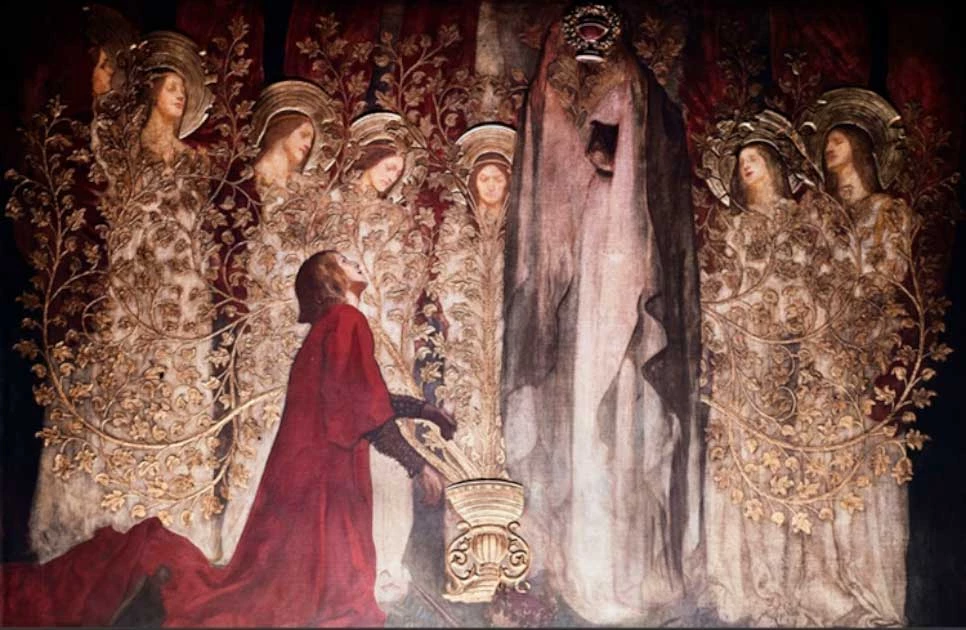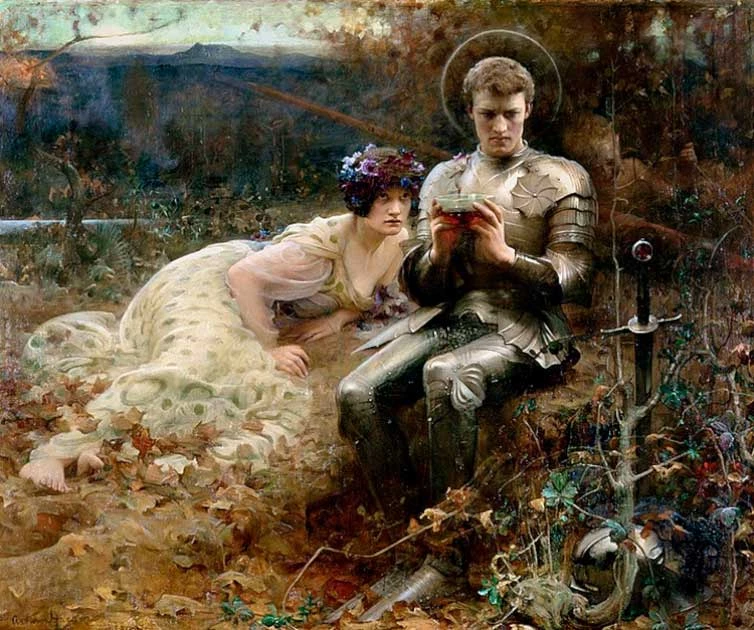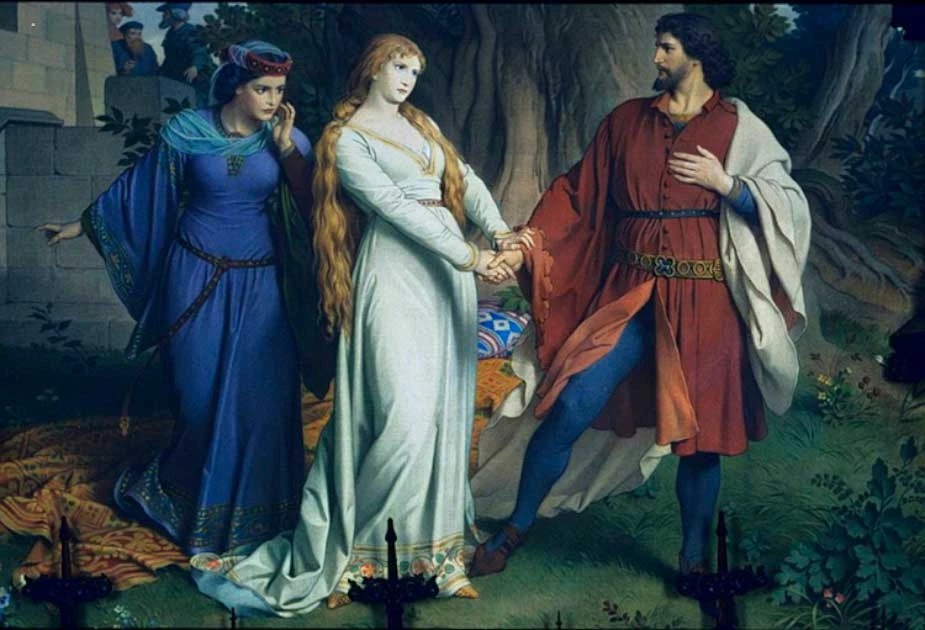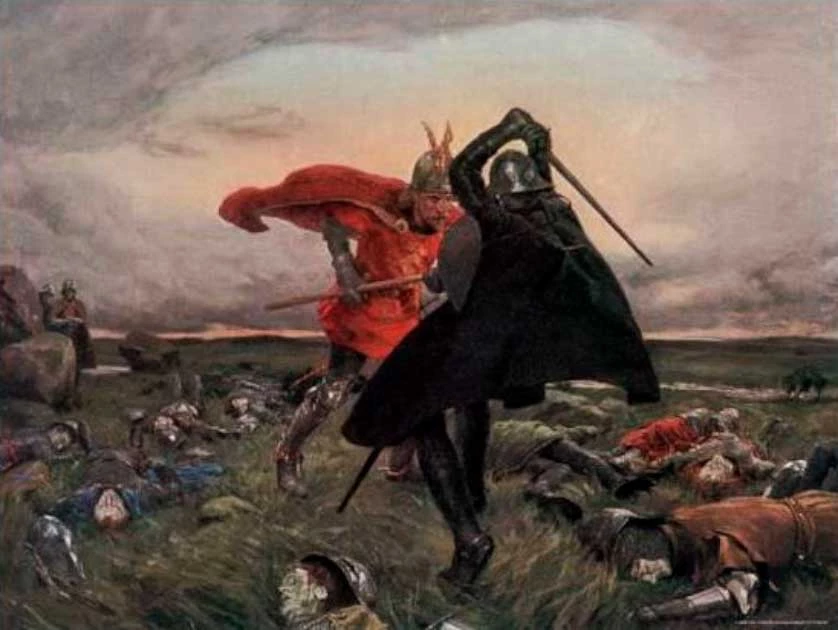The legend of King Arthur is a source of deep frustration for modern historians, many of whom see any attempt to find the historical facts behind the story as a recipe for career-ending disaster. Better to stick to what we can see existed than to chase after fantasy based on accounts written centuries later.
Perhaps what is most frustrating is e very thinness of the veil Arthur hides behind. We know of historical figures, kings and nations with whom Arthur interacted, and we can even trace the course of history during this time, seeing England revealed as a land where the inhabitants are driven westward by waves of Saxon immigrant invaders.
But how Arthur fits into this narrative, we cannot say. His story, of great victories but ultimate sorrow, shadows that of his people, who bravely fought the Saxons before being consumed by them.
In later centuries the facts, if indeed there are any, have been replaced by metaphor, and the stories of his knights have been gathered together under the (decidedly later) theme of chivalric honor, personal bravery, and sacrifice. Here are ten of Arthur’s most prominent knights, and what happened to them.
1. Sir Lancelot
Where else to start but with Lancelot? Sir Lancelot de Luc (“of the Lake”) is the orphaned son of King Ban of Benwick (another unknown kingdom), raised by fairies to become perhaps Arthur’s greatest knight.
Often shown as the victor in any test of martial prowess, he is the strongest, the most skilled, and the most noble of the Knights of the Round Table, and is often seen as the greatest as well. Yet what makes him the most interesting is that he is not a perfect knight. It is his flaws that humanize him, and it is the tragedy in his humanity that continues to fascinate.
For Lancelot loved Guinevere, Arthur’s Queen. This love, often claimed to be magical or “fated”, is the seed of destruction at the core of Camelot, Arthur’s idealized kingdom. When he learns of the affair, Arthur sentences Guinevere to death and Lancelot’s bloody rescue of the queen causes the downfall of Camelot.
2. Sir Galahad
Sir Galahad is Lancelot’s illegitimate son, and is portrayed as a knight with all of his father’s strengths but none of his flaws. Born to Lancelot and Lady Elaine of Corbenic, daughter of the mysterious crippled Fisher King, he is the purest of Arthur’s knights.

Galahad appears quite late in the Arthurian tradition, and the legends are well established in the medieval French chivalric tradition by the time he is first mentioned. Fittingly, his purity permits him the victory denied to other, less perfect knights, for he is the one who finds the Holy Grail.
Galahad is much more entwined with Christian imagery than most of Arthur’s court, but in many other ways he is a later parallel of Arthur: his birth, upbringing, and emerging role as the first among equals all echo his king. His success in finding the grail is consistently put down to his purity of spirit, though it may have also helped that the Grail was found at the castle of his maternal grandfather.
3. Sir Gawain
Sir Gawain is an oddity in Arthur’s knights, in that he is very much his own thing, a figure out of Welsh mythology who became attached to Camelot. Arthur is only a background figure in his most famous depiction, in Sir Gawain and the Green Knight.
- Was King Arthur Real? Examining the Historical Record
- What Can We Know about the Poet Who Wrote Gawain & the Green Knight?
This odd, deliberately anachronistic poem has Gawain behead a mysterious knight in a duel at Arthur’s court, only for the knight to survive and hold Gawain to his oath to receive a similar blow a year hence. Gawain’s journey to the Green Knight’s chapel the next year and his adventures are how we know him best.
Gawain changes through the centuries, supplanted as a knightly ideal (and Arthur’s closest companion) first by Lancelot and then by Galahad. Ultimately he is seen as sinful (which reeks of Christian revisionism against the deep pagan roots of this character) and, acting as Arthur’s second-in-command, is killed by Lancelot as Camelot falls.
4. Sir Perceval
Sir Perceval, or Sir Peredur, was another of the knights who quested for the Grail, the original in the medieval tradition before he was supplanted by Sir Galahad. But where Galahad was successful, Perceval failed.
Like so many of Arthur’s knights, Perceval is of noble birth, raised in secret and mocked at his first appearance at Camelot. He must prove himself worthy before he is admitted as a knight of the round table, which he achieves through his quest.

His flaw is in his imperfection. He reaches the Grail castle, like Galahad, but he fails to understand the task set for him and does not succeed in healing the Fisher King. The replacement of his failure with Galahad’s success is an interesting shift in narrative, perhaps a Christian overlay on the value of purity and the salvation offered by the church. One can only speculate why.
5. Sir Bors
There are actually two Arthurian knights named Bors. The first, the brother of King Ban of Benoic (which is likely the same as “Benwick” above, making Bors Lancelot’s uncle) was one of the earliest allies of Arthur, and he in instrumental in winning the brief peace against the Saxons during which Camelot can flourish.
The second Sir Bors is his son, and is the better known of the two in the legends. Another Grail knight, he is tested alongside Galahad and Perceval but ultimately proves himself worthy to witness the mysteries of the Grail.
Fighting on the side of Lancelot after the latter’s treachery with Guinevere, he survives the collapse of Arthur’s realm and becomes king of Frankish territories on the continent. Bors is the only central knight of the Arthurian Romance tradition to survive it.
6. Sir Geraint
Geraint might be a figure with an identifiable historical context, and potentially a real person. Records survive of a King Geraint who ruled Dumnonia (Devon and Cornwall in the far south west of England) in the 8th century. This is a very late date for one of Arthur’s knights, but it points to a lineage which may have included Sir Geraint.
Geraint the knight, like Gawain, is most famous for his own story, that of Geraint and Enid. One of three Welsh prose romances from the 12th century, it is possible that the later story used the earlier King Geraint’s name for a Welsh audience looking for familiar characters.
The story of Geraint centers on his love for Enid, and his adventures to prove that this love has not weakened him as a knight. Enid’s assistance and aid are a central feature in the tale, perhaps proving that beside every great knight is a woman supporting him.
7. Sir Bedivere
Sir Bedivere is filled with interesting characterization, perhaps because he is rarely the central character of the tales in which he appears. One handed (an interesting parallel with the Norse god Tyr) and a brave warrior, he often accompanies Arthur on his adventures where he proves pugnacious, loyal, and handsome.
- King Vortigern and the Search for Arthur’s Britain
- Searching for Camelot: The Truth Behind the Court of Arthur
His role as a supporting character means that it can be difficult to pick apart his story, but it seems he acts as a loyal companion throughout most of the Arthurian legends. He is chiefly remembered however for returning Arthur’s famous sword Excalibur to the Lady of the Lake after the fall of Camelot.
Reluctant to throw such a valuable weapon into the water, he twice hesitates. However he finally obeys the wish of his dying king and casts the sword out onto the water, only to see a hand rise and catch it (hopefully by the hilt). He then retires to a hermitage to live out his days in penance.
8. Sir Tristan
Tristan’s story echoes Lancelot’s, another flawed knight in Arthur’s court who is doomed by love. Charged to escort the lady Iseult to Cornwall where she is to marry his uncle King Mark, cementing an alliance, the couple drink a love potion and fall in love.

This story, retold in the famous 12th century chivalric romance Tristan and Iseult, does not end well for the lovers. King Mark, incensed by the betrayal of his nephew and his bride, senteces both to death. Originally Tristan is killed and Iseult eventually imprisoned, but the story fragments and there are many other versions.
Sometimes Mark kills Tristan with a magic lance, others he escapes to northern France to marry somebody else called Iseult. However, most poetically, both the lovers are killed but a bramble grows from Tristan’s grave, intertwining with a rose which grows from Iseult.
9. Sir Cei
Sir Cei, or Sir Kay, was Arthur’s foster brother, raised with him while Arthur was ignorant of his birthright. A bully, a thug and a simple man, he is also a formidable fighter and a loyal companion.
Like Sir Bedivere he is more of a supporting character, appearing alongside Arthur or in ensemble pieces where he is one of the knights. He has no great story of his own. He is most prominent in helping Arthur to defeat the giant of Mont St Michel, an island city on the coast of northern France.
Cei’s appearances in the narrative fall off as time progresses, and it is not clear if he participates in Arthur’s final battle. His role is more in the establishment of his king, and while he might be ridiculous at times, his loyalty is never questioned.
10. Mordred
Mordred, Arthur’s doom, is the most complex and multi-faceted figure in this list, but perhaps does not really merit inclusion at all. He is not usually remembered for his role as a Knight of the Round Table, but then it is not entirely clear who he truly is. Is he Arthur’s nephew, or his bastard son? Is he born of Arthur’s incest with his half-sister Morgause? Is he Gawain’s brother?
What is certain is that he is the chief antagonist at the Battle of Camlann, where Arthur is mortally wounded. His treachery, seizing power while Arthur is preoccupied with the betrayal of Lancelot (with whom he is sometimes equated), brings about the fall of Camelot.

Mordred dies at Camlann, perhaps beheaded by Arthur himself. Down the centuries his name has become a byword for treachery and faithlessness. He is the only of Arthur’s knights to be portrayed entirely negatively.
The Battle of Camlann is another of those Arthurian events which appear to have historical roots. Believed to have been fought in 537 AD, Arthur is mortally wounded and carried off to Avalon, where he sleeps until England needs him again.
Top Image: King Arthur and his knights receive a vision of the Grail. Interestingly the central figure is Lancelot, Arthur is two spaces to his left talking to Sir Cei. Source: Evrard d’Espinques / Public Domain.
By Joe Green